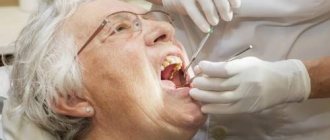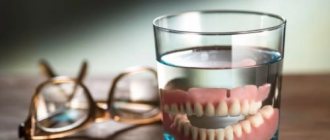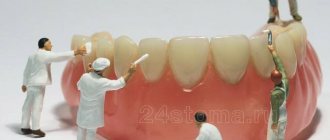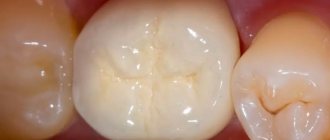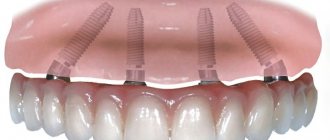People lose teeth for a variety of reasons, and such losses always need to be replaced so as not to disrupt the normal digestion process and the aesthetics of the dentition. When can prosthetics be done after tooth extraction? There is no clear answer to this question, since the clinical situation, the chosen type of prosthetics, and the condition of the tissues after the operation play a role here.
Implantation
The basis of the implant is a metal pin (titanium) that is installed in the jaw bone and replaces the tooth root. Implantation is used for the loss of one or more teeth or their complete absence. Implants made of metal-ceramic or metal-free ceramics can serve as support for a bridge structure.
The surgery is performed under anesthesia and can last 20-60 minutes. Depending on the specific situation, the implant is installed immediately after the removal of a damaged tooth or into already healed gums. The implantation scheme may vary depending on the need to build up lost bone tissue and gum formation.
The period of fusion of the metal root with bone tissue can take 3-6 months, after which the prosthesis is installed. During the implantation period, the patient can use a temporary crown.
The average service life of an implant is determined by its quality, the level of skill of the specialist, and the individual characteristics of the patient. Subject to medical recommendations - from 15 years to “for life”.
The period of adaptation to prostheses installed on implants can be several hours or 1-2 days.
Care products for implants are the same as for regular teeth:
- toothbrush with toothpaste;
- dental floss;
- rinsing or irrigation.
Twice a year it is necessary to undergo a preventive examination with a dentist. Professional cleaning is carried out as needed.
Installation of titanium root after 6 months or more
It is worth considering that this delayed implantation protocol is used only in the most advanced clinical cases.
Implant surgeons at Family Dentistry recommend implanting titanium roots in the period from 8 to 25 weeks after tooth extraction. At a later date, the risk of resorption (decrease in volume) of bone tissue increases. To restore the bone to normal volume, expensive osteoplasty surgery will be required.
For cases when alveolar process atrophy has already begun to manifest itself, there are 3 ways to build bone tissue to the required volume. And only after the process of complete osseointegration of bone materials can surgery be performed.
Sinus lifting open, closed and endoscopic type
Jaw type:
only for the top one.
Osseointegration period:
2-6 months.
Before the sinus lift procedure (scientific name subantral augmentation), the position and volume of the patient’s maxillary sinuses are examined. During the operation, the bottom of these sinuses is raised, and the resulting voids are filled with bone material.
| Type of sinus lift | Peculiarity |
| Closed | For low level bone tissue atrophy. The sinuses must be raised by 2-3 mm. |
| Open | Required for medium or critical level resorption. |
| Endoscopic | The procedure is performed using an endoscope. This is a low-traumatic type of surgery |
Guided regeneration
Jaw type:
for the bottom.
Integration period:
8-24 weeks.
Operation stages:
- a small surgical incision is made in the gum;
- in places where there is insufficient volume of the alveolar ridge, bone-forming material is added;
- the surgical site is “covered” with a biomembrane, which accelerates the process of osteogenesis;
- The gum is sutured until the osteoplastic tissue is completely engrafted.
Note:
Over time, the biomembrane dissolves under the soft tissue of the gums.
Primary and secondary autotransplantation
Jaw type:
for top and bottom.
Engraftment period:
2-6 months.
A bone block of the required size is transplanted from the patient himself (this avoids rejection of the material) to where the implantation will be performed.
This bone block can be surgically removed from the area of the third molar (wisdom tooth), chin, base of the skull or pelvic bone.
| Type of autotransplantation | Indications |
| Primary | Used immediately after injury or surgery (for example, removal of a tumor, cyst, etc.) |
| Secondary | It is used if more than six months have passed since injury or surgery (in some clinical cases, complete healing of the injury is necessary). |
Removable dentures
A removable denture is a base made of plastic or nylon on which artificial porcelain or plastic teeth are attached. The structure is fixed in the mouth with micro-locks, clasps, telescopic crowns or due to the suction effect. Removable dentures are used for unlimited dental defects and complete absence of teeth.
There are several types of removable dentures based on the type of fastening and base material:
- clasp;
- nylon;
- plastic with silicone gasket;
- plastic partial or complete.
Conventionally, removable clasp dentures are fixed using telescopic crowns, attachments, and clasps. They are used only in cases of partial absence of teeth. It is the most comfortable, functional and durable type of removable dentures.
A soft nylon denture is recommended in partially edentulous cases. Fits well and is easy to use.
Plastic ones with a silicone gasket are also convenient. Dentures of this type adhere more tightly and put less pressure on the gums.
Plastic full or partial are an outdated type of dentures. A budget option, which is the basis of all social programs for free prosthetics. Plastic structures are poorly fixed in the oral cavity and cannot chew solid food well.
Don't be alarmed if...
- If the gums around the wound and the outside of the cheek are swollen and painful. This is a natural reaction to surgery. Swelling can be reduced with cold or ice, but it will be worst around the third day after surgery, and bruising may occur. Afterwards, the swelling and pain will subside.
- If during the first hours after surgery the gums bleed slightly. We emphasize - lightly . If the bleeding is severe and a blood clot does not form in the socket, this is a reason to consult a doctor.
- If you have a mild fever, the corners of your mouth become dry and cracked. This is also a sign that the body has begun healing the wound and fighting possible bacteria.
- If you cannot open your mouth wide for the first three days after surgery. And they shouldn't.
"Butterfly"
A removable microprosthesis “butterfly” comes to the rescue when 1-2 teeth are missing. The technique is used to eliminate defects in the frontal area. Its advantages:
- speed - 1-2 visits to the orthodontist;
- no need to grind adjacent teeth;
- high aesthetics;
- low price.
The “butterfly” can be made of metal ceramics, entirely of plastic on a cast frame, or with a metal wire fastening. The technique is not used to restore the dentition on the lateral areas of the jaw, which experience significant stress when chewing food.
The process of prosthetics begins with diagnosing the condition of the teeth, cleaning them from tartar, filling and removing teeth, treating gums and other measures. The period from the time of tooth extraction to the installation of a bridge, clasp or plate prosthesis is from 1 day to 1-2 months.
The technique of one-stage prosthetics is used for:
- absence of inflammatory processes and infections in the oral cavity;
- good condition of gums, teeth, bone tissue.
The general physiological condition of the patient is taken into account.
According to statistics, installation of removable dentures in place of extracted teeth is possible in 1-4 weeks.
It may take from several hours to several weeks to get used to. Not only the skill of the specialist, but also the psychological mood of the patient is of great importance. Pain may not appear immediately. Correction can be carried out no earlier than the next day, provided that the structure is in the mouth for at least 4 hours. Several adjustments may be needed.
In the first days, a speech defect is usually observed, its severity is determined by the degree of bulkiness of the structure. Patience and regular exercise will help you get rid of it in 1-3 days.
The service life of removable dentures is 5-10 years, determined by the condition of the gums and teeth (for clasp dentures).
Caring for removable dentures is similar to caring for living teeth - brushing and rinsing. Removable dentures should always be kept in a damp environment. Using a fixing cream or gel will ensure a tight fit of the structure to the gum and prevent food debris from getting under the denture. For disinfection, special antiseptic agents are used, available in the pharmacy chain.
Even if your teeth are completely missing, regular visits to the dental office are recommended to monitor the condition of the oral mucosa. If there are no problems, you should visit an orthopedic dentist at least once a year. The specialist will assess the condition of the structure and, if necessary, make corrections.
Fixed dentures
Fixed dentures are rigidly fixed in the oral cavity with cement compounds. They are designed to restore various defects of teeth and dentition. This:
- crowns;
- bridge structures.
Single crowns can restore the anatomical shape of a damaged tooth with preserved stability and root structure. They are made of metals, plastics, ceramics, as well as metal-plastic and metal-ceramics.
Bridge structures are bridges that completely cover the area with missing teeth. The pontic consists of artificial teeth, and the supports are made of crowns that are attached to strong teeth. When chewing food, pressure is evenly distributed throughout the dentition. Bridge structures can be solid metal or combined - metal and plastic, metal and ceramics.
Installation of fixed dentures can be carried out over several visits: grinding of the supporting teeth and making an impression, fitting of the prosthesis, correction of the structure and its fixation.
After tooth extraction, fixed dentures can be installed immediately after the wound has healed - 7-10 days. If the period of preparation for prosthetics takes a long time, the patient is made of temporary dentures for the front part of the dentition.
The less time has passed since the damage/loss of the tooth, the shorter the adaptation period.
The durability and reliability of removable dentures are determined by the general health of the patient and proper care.
Caring for removable structures consists of carrying out the usual activities: brushing your teeth with toothpaste, rinsing your mouth with special compounds. The use of dental floss is not recommended, as there is a risk of damaging the denture attachment. Regular visits to the dentist's office for diagnostic, preventive and therapeutic measures will help preserve the remaining teeth and extend the life of fixed dentures.
Other useful material
New implantation technologies without bone grafting
Open and closed sinus lift during implantation
Implantation of several teeth in a row
Implant installation
General recommendations
During the period of adaptation to dentures, it is recommended to stop eating solid foods and choose softer foods. It is recommended to eat slowly, cutting food into small pieces. You need to chew food on the right and left sides in turn. To restore chewing skills, pear or apple slices are suitable.
It is necessary to completely avoid chewing gum, toffees, toffees and other viscous, sticky products. They can cause disruption of the fixation of the prosthesis, its breakage, and injury to the mucous membrane.
Do not clean dentures with abrasives, alcohol, alkaline or acidic solutions. The use of hard toothbrushes is not recommended. You should not chew candy, nuts, or seeds.
If you have any doubts or need a professional opinion on a problem with your prosthesis, you can contact the Canadian Center for Innovative Technology and Neuromuscular Therapy for a consultation. Our specialists will answer all your questions!
